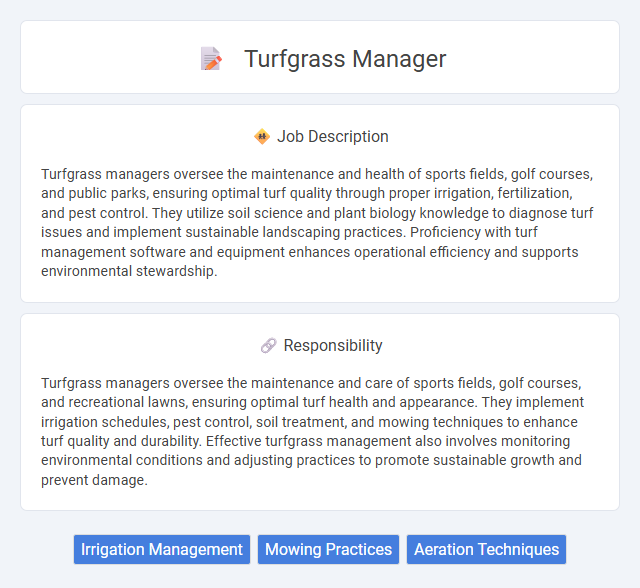
Turfgrass managers oversee the maintenance and health of sports fields, golf courses, and public parks, ensuring optimal turf quality through proper irrigation, fertilization, and pest control. They utilize soil science and plant biology knowledge to diagnose turf issues and implement sustainable landscaping practices. Proficiency with turf management software and equipment enhances operational efficiency and supports environmental stewardship.
Individuals who enjoy working outdoors and have a strong interest in horticulture and landscape maintenance are likely to be well-suited for a turfgrass manager role. Candidates with good physical stamina, attention to detail, and problem-solving skills might adapt effectively to managing turf health and irrigation systems. Those who prefer desk jobs or minimal physical activity may find this position less compatible with their preferences and abilities.
Qualification
Turfgrass managers typically require a bachelor's degree in agronomy, horticulture, or turf management, supplemented by hands-on experience with turfgrass maintenance and soil management. Proficiency in pest control, irrigation systems, and sustainable landscape practices enhances job performance. Certification from the Golf Course Superintendents Association of America (GCSAA) or similar organizations is highly valued for career advancement.
Responsibility
Turfgrass managers oversee the maintenance and care of sports fields, golf courses, and recreational lawns, ensuring optimal turf health and appearance. They implement irrigation schedules, pest control, soil treatment, and mowing techniques to enhance turf quality and durability. Effective turfgrass management also involves monitoring environmental conditions and adjusting practices to promote sustainable growth and prevent damage.
Benefit
A Turfgrass manager likely benefits from developing expertise in plant science and landscape management, which can lead to career growth and increased job stability. There is a probability of gaining rewarding opportunities in sports facilities, golf courses, and parks where maintaining healthy and aesthetically pleasing turf is critical. The role may also offer benefits such as working outdoors and contributing to environmental sustainability through effective turf maintenance practices.
Challenge
Turfgrass managers likely face the challenge of maintaining healthy, resilient turf despite fluctuating weather conditions and pest pressures. Managing irrigation efficiently and controlling diseases without overusing chemicals may pose ongoing difficulties. Balancing aesthetic expectations with environmental sustainability is probably a complex aspect of this role.
Career Advancement
Turfgrass managers oversee the maintenance and health of sports fields, golf courses, and parks, utilizing expertise in soil science, irrigation, and pest control. Career advancement often includes roles such as superintendent, landscape director, or specialized consultant positions, with opportunities to lead larger teams or manage multiple sites. Gaining certifications like the Golf Course Superintendents Association of America (GCSAA) Certified Superintendent credential significantly enhances prospects for higher-level management and industry recognition.
Key Terms
Irrigation Management
Turfgrass managers specializing in irrigation management optimize water usage by implementing advanced irrigation systems and scheduling based on soil moisture data and weather patterns. Precise control of irrigation enhances turf health, prevents water waste, and ensures sustainable maintenance of sports fields, golf courses, and landscapes. Expertise in sensor technology and irrigation software allows effective monitoring and adjustment to promote deep root growth and prevent disease.
Mowing Practices
Turfgrass managers implement precise mowing practices to maintain optimal grass height, promoting healthy growth and preventing weed invasion. They adjust mowing frequency and blade height according to turf species and seasonal conditions to enhance turf density and color. Effective mowing practices also minimize stress on the grass, reducing susceptibility to diseases and improving overall turf quality.
Aeration Techniques
Turfgrass managers implement advanced aeration techniques such as core aeration, slit aeration, and liquid aeration to improve soil oxygen levels, water infiltration, and root growth, directly enhancing turf health and resilience. These aeration practices reduce soil compaction and promote nutrient absorption, which is critical for maintaining high-quality turf on golf courses, sports fields, and lawns. Effective aeration scheduling based on soil type and turf species optimizes turfgrass density and durability, supporting sustainable turf management and aesthetic standards.
 kuljobs.com
kuljobs.com